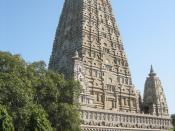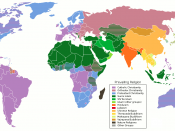Religion is a philosophy or a state of mind. It is a concept which goes into extensive depth past the literal perspective. A religion consists of traditions, sub-traditions, and a recognition of a transcendental Being or goal (source: class handout). One way of understanding such a broad topic is through Ninian Smart's model for studying religion. This model allows observers to compare similarities and differences with any religion and gives reasoning for a 'religion' to be classed as one or not. Smart's model uses seven dimensions to analyse religions, of which some dimensions have less significance than others in a particular religion. Buddhism can be seen as the most abstract of the major world religions, primarily due to it being an atheistic religion. Smart's model allows observers to see the similarities which it mutually shares with other major world religions shown through the: Practical and Ritual, Ethical and Material dimensions.
Religion is a philosophical concept of the mind composed of many diverse characteristics. Religion can be based on: faith in a supernatural power or being, belief, possible answers to human existence and, even guidelines to live life. Religion allows believers to have faith that life continues after death on earth, and interpret their roles in the universe. A concise definition of the common term 'religion' is inadequate because of its ambiguity and can be contradictory. (Tillich, P, 2000) Religion is in essence a belief system. Science has shown calming effects of religion and can be more beneficial than one realises. "â¦belief in God works works much like an anti-anxiety drug, creating a buffer against defensive or distressed reactions to the mistakes we make." (Harris, M, 2010) The power of the mind and its religious influences, impacts the way people perceive and carry out life which can be associated with...


